StarWind iSCSI SAN & NAS: Multipathing
- October 25, 2012
- 9 min read

INTRODUCTION
The diagram below illustrates the network architecture used in this document.

CONFIGURING STARWIND SERVER
1. Open a StarWind configuration file.
Note: The default path is C:\Program Files\StarWind Software\StarWind\StarWind.cfg
2. Find the string “<!–<iScsiDiscoveryListInterfaces value=”1″/>–>” and uncomment it (should look as follows: <iScsiDiscoveryListInterfaces value=”1″/>).
3. Restart StarWind Service.
4. Launch StarWind Management Console: Start -> All Programs -> StarWind Software -> StarWind.
Note: The StarWind Console icon appears in the system tray when the Console is running. To open StarWind Management Console, double-click the icon or right-click it and then select Start Management Console from the shortcut menu.
5. Select the server you want to provide with the iSCSI target device from the Console tree. Double-click the host to connect.
Note: If you are prompted to enter login and password, specify “root” and “starwind”, relatively. These are the default login and password, but you can always change them later.
6. After connecting to StarWind Service, you can create devices and targets on the server. Open Add Device Wizard by one of the following ways:
• Select Add Device from the Target menu.
• Select Add Device from the Devices shortcut menu (right-click to open it).
7. Add Device Wizard appears. Please, follow the wizard’s steps to complete creation of a new image file device.
8. Select Virtual Hard Disk -> Image File device.
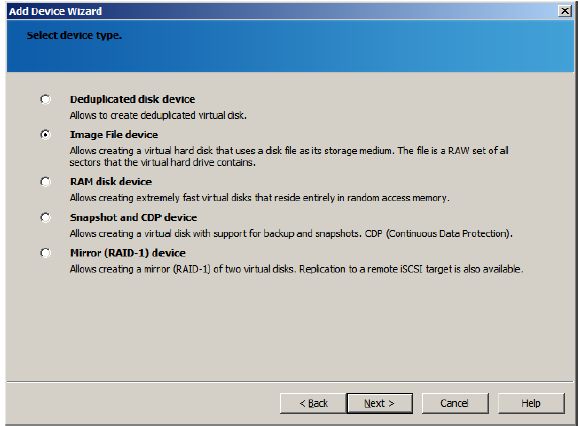
9. Click Next to continue.
10. Select the Create new virtual disk option.

11. Click Next to continue.
12. Specify required virtual disk parameters.

13. Click Next to continue.
14. Select a virtual disk that will be made accessible via iSCSI.

15. Click Next to continue.
16. Specify cache parameters of an image file device.

17. Click Next to continue.
18. Specify target parameters. Select Allow multiple concurrent iSCSI connections (clustering) checkbox.

19. Click Next to continue.
20. Check whether device parameters are correct. Click Back to make any changes. Click Next to continue.
21. Click Finish to close the wizard.
CONFIGURING ISCSI CLIENTS
Windows Server 2008
1. Launch Server Manager, select the Features item and click Add Features. Select Multipath I/O from the features list. Follow the wizard’s instructions to install it.
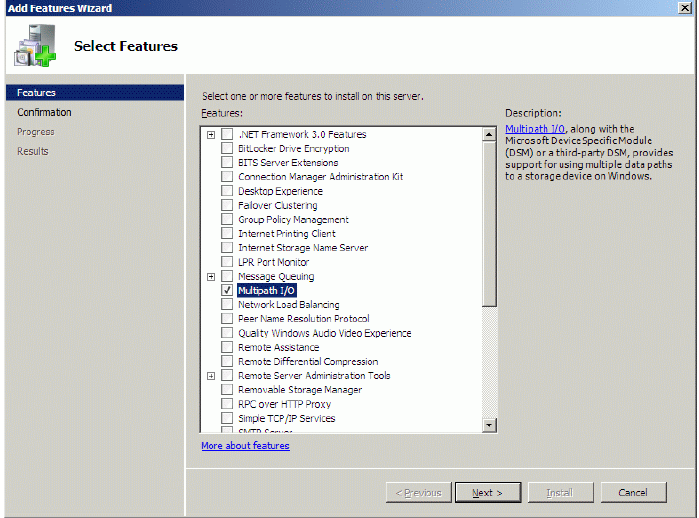
2. Launch Microsoft iSCSI Initiator: Start > Administrative Tools > iSCSI Initiator. Navigate to the Discovery tab.
3. Click Discover Portal. In the Discover Target Portal dialog enter the first IP address of the StarWind Server. Click OK.
4. Click Discover Portal again. Enter the second IP address of the StarWind Server. Click OK.

5. Navigate to the Targets tab. The previously created target is listed in the Discovered Targets section.
Note: If the created target is not listed, check the firewall settings on the StarWind Server as well as a list of networks served by the StarWind Server (go to StarWind Management Console -> Configuration -> Network).
6. Select the target and click Connect.
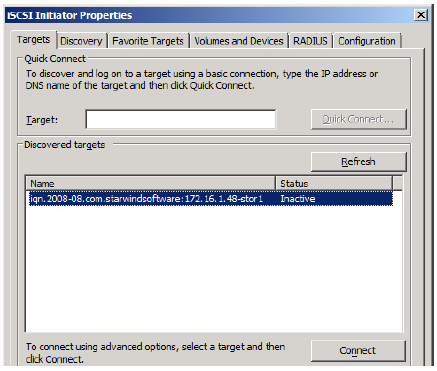
7. In the Connect to Target dialog select Add this connection to the list of Favorite Targets and Enable multi-path checkboxes. Click Advanced.

8. Select Microsoft iSCSI Initiator in the Local adapter text field. In the Target portal IP select the first IP address of the StarWind Server.

9. Click OK. As you return to the previous dialog, click OK to go back to iSCSI Initiator Properties.
10. Select the same target and again click Connect.

11. Perform the same actions as described above; this time specify another IP address as a target portal IP. Click OK.

12. Connect the second path of the target and close the MS Initiator.
13. Open the MPIO manager: Start -> Administrative Tools -> MPIO.
14. Go to the Discover Multi-Paths tab. Select the Add support for iSCSI devices checkbox and click Add.

15. When prompted to restart the server, click Yes to proceed.
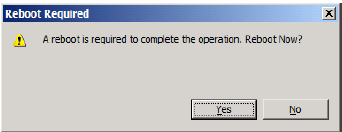
16. After the system reboot open the MPIO Manager again to ensure that the multipathed device has been recognized and added. A new device has to be displayed in the Devices list of the MPIO-ed Devices tab.

17. Open the iSCSI Initiator and view the target properties. Select the target and click Properties.

18. The Sessions tab contains two sessions that represent both network paths that you have set.

19. Click Devices. This window displays general information about devices.

20. Click MPIO. Select a load balance policy of your connections. A brief description of the selected policy is provided beneath the Load balance policy box.

Windows Server 2012
1. Launch Server Manager, select the Manage item and click the Add Roles and Features option. Install the Multipath I/O feature by following the wizard’s steps.
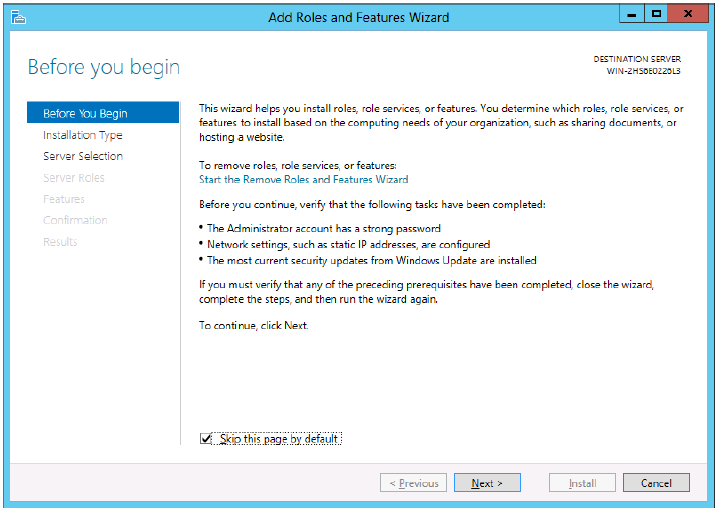
2. Click Next.
3. Select Role-based or feature-based installation as an installation type and click Next to continue.

4. Select the Select a server from the server poll option and select the appropriate server.
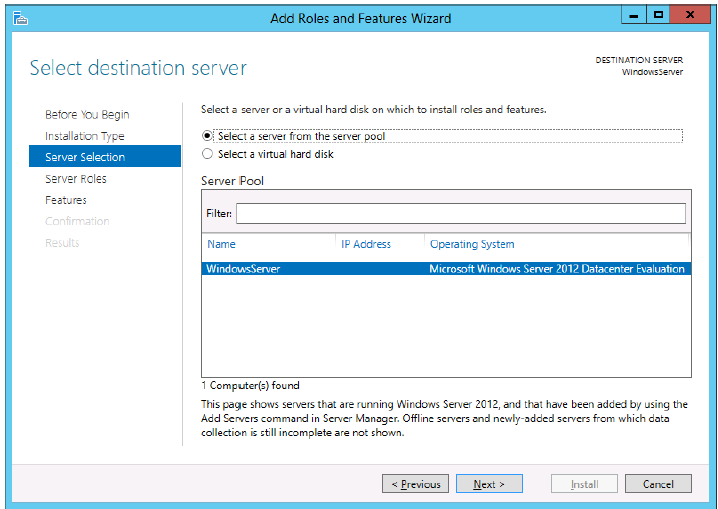
5. Click Next.
6. In the features list select Multipath I/O feature and install it.

7. Launch Microsoft iSCSI Initiator: Start > Administrative Tools > iSCSI Initiator. The iSCSI Initiator Properties window appears.
8. Navigate to the Discovery tab.
9. Click Discover Portal. Enter the first IP address of the StarWind Server in the appropriate field of the Discover Target Portal dialog. Click OK.
10. Again click Discover Portal to add the second IP address of the StarWind Server.

11. Click the Targets tab. The previously created targets are listed in the Discovered Targets section.
Note: If created targets are not listed, check the firewall settings of the StarWind Server as well as the list of networks served by the StarWind Server (go to StarWind Management Console -> Configuration -> Network).
12. Select the targets and click Connect to add it.
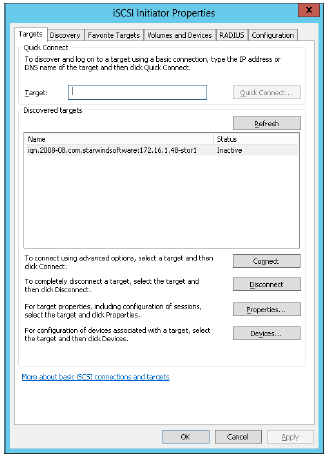
13. Select Add this connection to the list of Favorite Targets and Enable multi-path checkboxes in the Connect to Target dialog. Click Advanced.
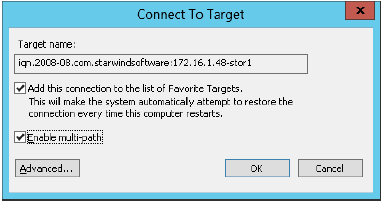
14. Select Microsoft iSCSI Initiator in the Local adapter text field. In the Target portal IP select the first IP address of the StarWind Server. Click OK.

15. Click OK to return to MS Initiator main window.
16. Select the same target and again click Connect. Perform the same actions as described above; this time specify another IP address as a target portal IP. Click OK.
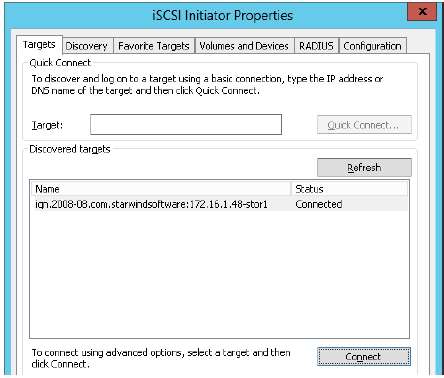
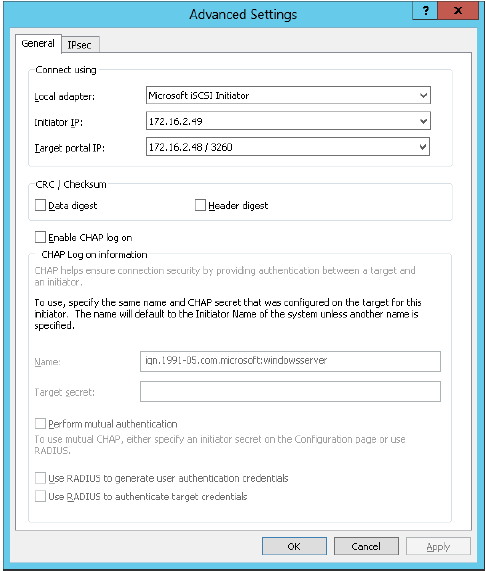
17. Connect the second path of the target and close the MS Initiator.
18. Open the MPIO manager: Start -> Administrative Tools -> MPIO.
19. Go to the Discover Multi-Paths tab. Select the Add support for iSCSI devices checkbox and click Add.

20. When prompted to restart the server, click Yes to proceed.
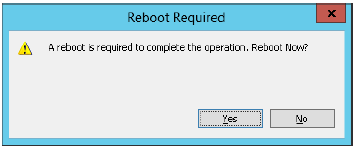
21. After the system reboot open the MPIO Manager once again to check whether the multipathed device has been recognized and added. A new device should be displayed in the Devices list of the MPIO-ed devices tab.

22. Open the iSCSI Initiator to check the target properties. Select the target and click Properties.
23. The Sessions tab contains two sessions that represent both network paths that you have set.
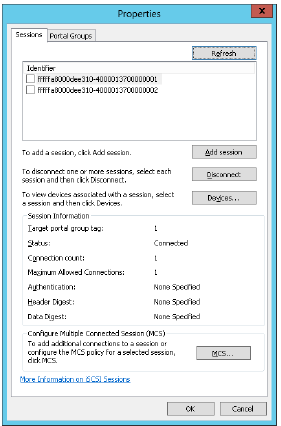
24. Click Devices. This window displays general information about devices.
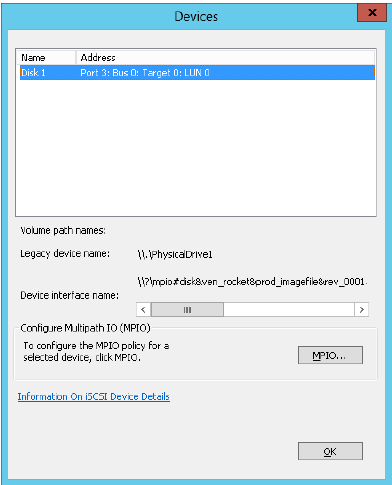
25. Click MPIO. Select a load balance policy of your connections. A brief description of the selected policy is provided beneath the Load balance policy box.



